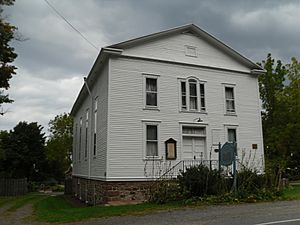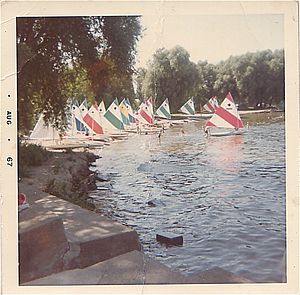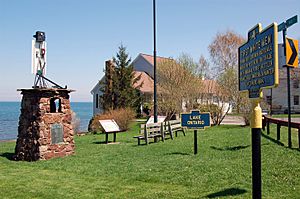Pultneyville, New York facts for kids
Quick facts for kids
Pultneyville, New York
|
|
|---|---|
|
Hamlet and CDP
|
|

Gates Hall
|
|
| Country | United States |
| State | New York |
| County | Wayne |
| Town | Williamson |
| Established | 1806 |
| Area | |
| • Total | 2.34 sq mi (6.07 km2) |
| • Land | 2.34 sq mi (6.07 km2) |
| • Water | 0.00 sq mi (0.00 km2) |
| Elevation | 272 ft (83 m) |
| Population
(2020)
|
|
| • Total | 817 |
| • Density | 348.55/sq mi (134.55/km2) |
| Time zone | UTC-5 (EDT) |
| • Summer (DST) | UTC-4 (EDT) |
| ZIP Code |
14538
|
| Area code(s) | 315 and 680 |
| FIPS code | 36-59993 |
| GNIS feature ID | 2631637 |
Pultneyville is a small community called a hamlet in Wayne County, New York, United States. It is part of the Town of Williamson. In 2020, about 817 people lived there.
Pultneyville is located where Salmon Creek meets Lake Ontario. It sits on the southern shore of the lake. The community was first planned in 1806. It is now recognized as a historic place. Pultneyville was once an important port for trading on the Great Lakes. It was also the site of a small battle during the War of 1812. Today, it is a peaceful place where many people live and travel to work in nearby cities.
The hamlet is surrounded by fruit orchards and is right on the Seaway Trail. Many activities in Pultneyville happen in the summer. These include sailing and theatre. The community has a busy marina (a place for boats). It is also home to one of the oldest community theaters in the United States.
Contents
History of Pultneyville
French explorers and traders visited the area around Salmon Creek in the late 1600s. They traded with Native American groups. However, no lasting settlements were built until around 1800. In 1687, a French army of 1,600 soldiers landed here from Canada. Their goal was to defeat the Iroquois people. This army later defeated the Senecas near what is now Victor, New York, about 25 miles south.
Pultneyville is named after Sir William Pulteney, 5th Baronet. He was a politician from Scotland who also bought and sold large areas of land. In 1790, Pulteney and his partners bought about 1,000,000 acres of land. This land was part of the former Phelps and Gorham Purchase.
It is not fully clear when the first settlers arrived. Some records say Dan Russell was the first white person to live there in 1794. Others say "Yankee" Bill Waters arrived in 1804. Waters built his cabin on the land just north of the harbor. In 1806, Jacob W. Hallet, who worked for Pulteney, bought 1,000 acres of the "Pulteney Estate." The first post office was set up in 1806, with Hallet as the postmaster. Most early settlers were from England or Scotland. Later, many Dutch Americans also moved to the area.
The War of 1812 Skirmish
On May 15, 1814, British forces landed in Pultneyville. They were led by Sir James Lucas Yeo. Yeo's group had already attacked Oswego to the east. They had also tried to attack Rochester to the west without success. They came to Pultneyville to get supplies.
Yeo and American Brigadier-General John Swift talked. They agreed that the British could take public supplies. In return, they would leave private property alone. However, Swift's soldiers then started shooting at the British. In the fight, two Americans were killed and three were hurt. The British took two more Americans as prisoners. The British then went back to their ships. Yeo's group fired back at the Americans before leaving.
Yeo's official report said that an agreement was made in Pultneyville. He stated that their flag of truce was shot at while they were loading flour. A newspaper in Canandaigua reported a different story. It said that Yeo's men landed before talks were finished. The newspaper claimed that General Swift's small force fired from the woods. This caused the British to leave. The British then fired cannons from their ships at the town. This caused some damage to houses. The two American prisoners were taken to Halifax, Nova Scotia. They were released two months later.
Pultneyville as a Trading Port
In the early 1800s, Pultneyville was a busy place for farming and shipping. Goods from as far south as Canandaigua were brought here. Pultneyville was the only port in Wayne County until the Erie Canal opened in 1823. From about 1811 to the 1890s, ships from this small community traveled to the Atlantic Ocean. They reached cities like New York City, Boston, and Baltimore through the Saint Lawrence River.
By 1865, nearly 30 Great Lakes ship captains lived in Pultneyville. Many sailors from Pultneyville also worked on whaling ships around the world. In 1874, the first railroad line, the Lake Ontario Shore Railroad, opened. This caused trade to move three miles south to Williamson. Pultneyville's importance as a trade center quickly decreased. The customs office, which handled trade paperwork, closed in 1892.
Landmarks and Events
In 1985, parts of Pultneyville were named a historic district. It was added to the National Register of Historic Places as the Pultneyville Historic District. This honor recognizes the community's important buildings. These buildings show styles like Federal, Second Empire, and Greek Revival.
Gates Hall
Gates Hall is a building that was built in 1825. It was first used as a church for different religious groups. Today, it is still used for performances and meetings. Gates Hall is also listed on the National Register of Historic Places (since 2000). It is recognized for its architecture, social history, and performing arts.
In the mid-1800s, many important talks were held at the church. These included discussions about avoiding alcohol, ending slavery, and supporting women's suffrage (women's right to vote). During the Civil War, the church was used to pack supplies for Union Army soldiers.
In 1867, a group called the Pultneyville Lyceum started putting on plays. They used gasoline lamps as spotlights. Since 1961, community theater groups have continuously performed in the building. Because of this long history, the Library of Congress has called Gates Hall the second-oldest community theater in the United States.
Geography
Pultneyville is located at 43°16′47″N 77°11′10″W / 43.27972°N 77.18611°W.
The community covers a total area of about 2.2 square miles (6.07 square kilometers). All of this area is land.
Population Information
| Historical population | |||
|---|---|---|---|
| Census | Pop. | %± | |
| 2020 | 817 | — | |
| U.S. Decennial Census | |||
As of the 2010 census, there were 698 people living in Pultneyville. There were 293 households and 229 families. The population density was about 317 people per square mile. Most of the people (96.6%) were White.
There were 293 households. About 21.8% of these had children under 18 living with them. Most households (67.6%) were married couples. About 18.8% of all households were single individuals. About 7.8% of these were people aged 65 or older living alone. The average household had 2.38 people.
The population was spread out by age. About 20.0% were under 20 years old. About 22.3% were 65 years or older. The average age was 48.3 years.
The average income for a household in Pultneyville was $90,625. For families, the average income was $105,139.
Housing
There were 336 housing units in Pultneyville. About 12.8% of these homes were empty.
Out of the 293 homes that were lived in, 271 were owned by the people living there (92.5%). Only 22 homes were rented (7.5%). A small number of owned homes (1.1%) were empty. A slightly higher number of rental homes (4.3%) were empty.
It is common for vacation areas to have more empty homes. Many of these are vacation homes that are not lived in all year.
See also
 In Spanish: Pultneyville (Nueva York) para niños
In Spanish: Pultneyville (Nueva York) para niños




